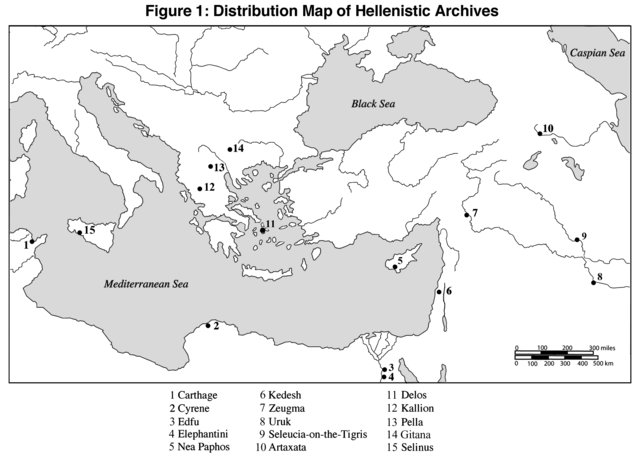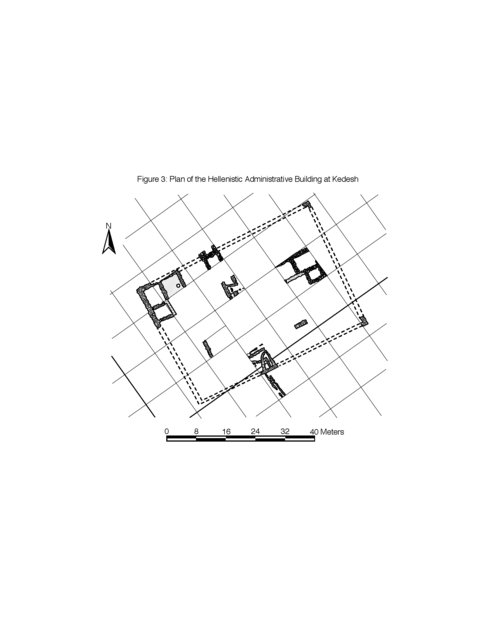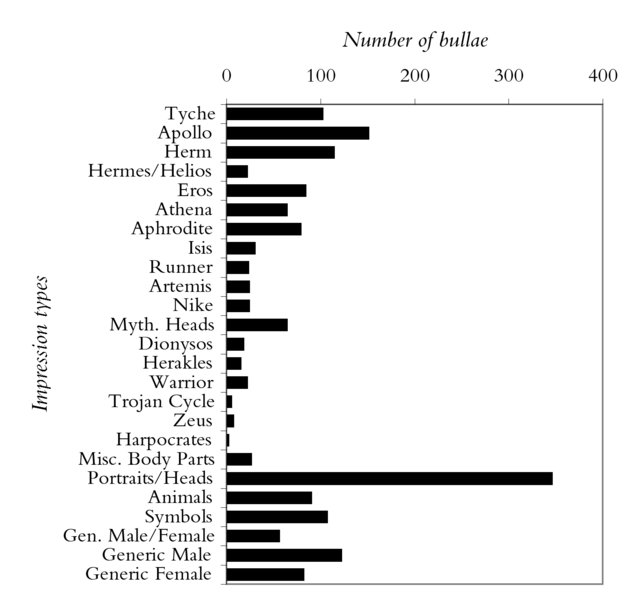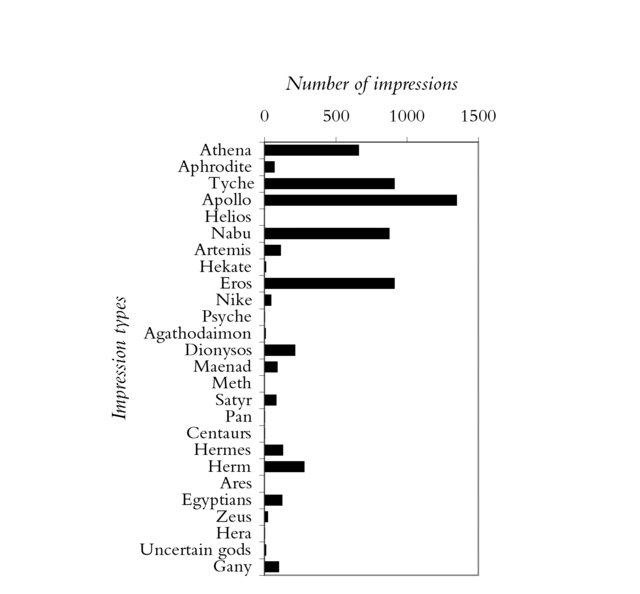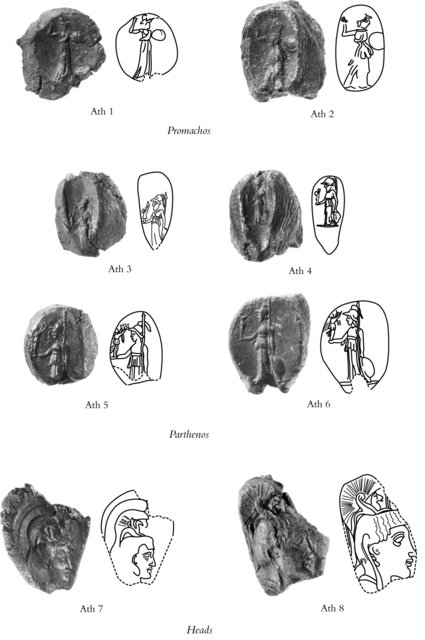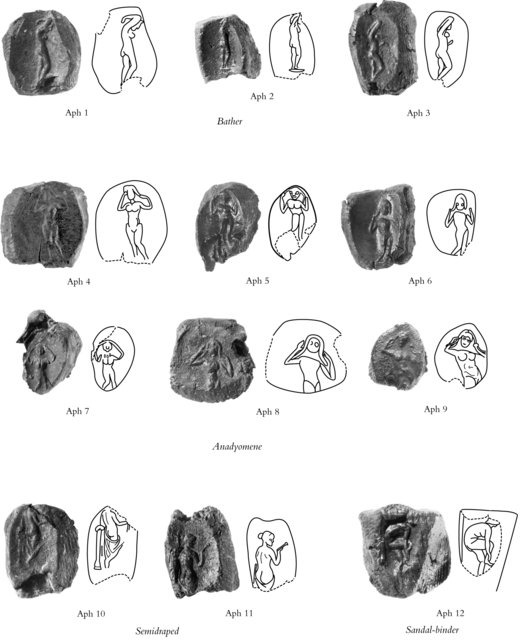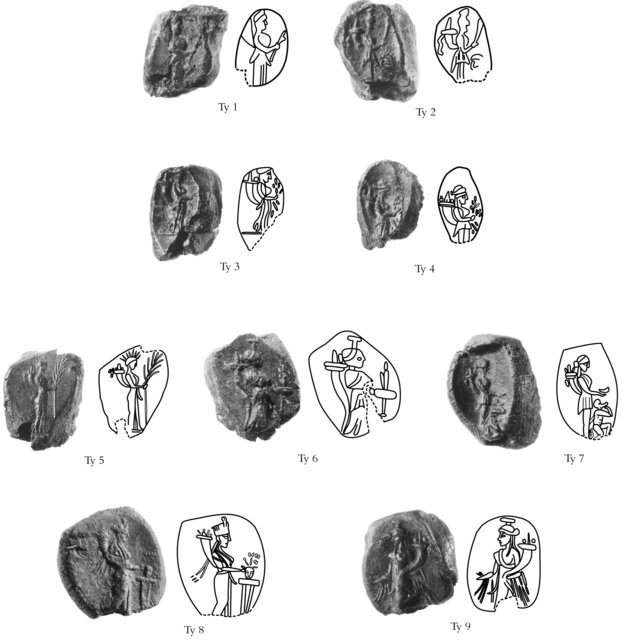- Print article
- Download PDF 416kb
The Hellenistic Archives from Tel Kedesh (Israel) and Seleucia-on-the-Tigris (Iraq)
Skip other details (including permanent urls, DOI, citation information)
: This work is protected by copyright and may be linked to without seeking permission. Permission must be received for subsequent distribution in print or electronically. Please contact mpub-help@umich.edu for more information.
For more information, read Michigan Publishing's access and usage policy.
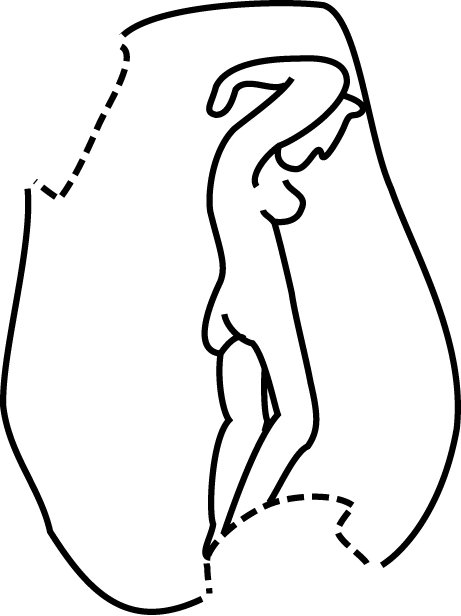
In January 1930, a University of Michigan team excavating in Iraq at Seleucia-on-the-Tigris, the eastern capital of the Hellenistic Seleucid kingdom, uncovered a cache of clay sealings that now reside in the Kelsey Museum (McDowell 1931, 26). These are pieces of clay or bitumen, which carry impressions of individuals’ seal rings. Such items, commonly known as bullae, were used to close and notarize papyrus documents in the Achaemenid, Hellenistic, and Early Roman eras. The Michigan team’s 1930 finds proved to be the first of two private archives located beneath the second/first century BCE block of Parthian houses excavated in their six seasons at Seleucia. The sealings from the two archives came to a total of 166 pieces (McDowell 1935, vii, 10–14).[1] Seventy years later another Michigan team discovered a roughly contemporary archive (open from 200 to 145 BCE) of more than 2,000 seal impressions at Tel Kedesh in the Upper Galilee of modern Israel (Herbert and Berlin 2003, 51–53). Meanwhile, an Italian team excavating at Seleucia in the 1960s and 1970s found a large public archive building of Hellenistic date containing upward of 25,000 sealings (Invenizzi 1985; Bollati and Messina 2004); these carried dates of between 257 and 154 BCE (Messina and Mollo 2004, li).
At the time of their discovery, the Michigan bullae from Seleucia comprised two of the very few excavated, and therefore securely datable, Hellenistic archives.[2] Most of what was then known about Hellenistic seals and sealing practices came from scattered surface finds at archaeological sites and largely unprovenanced gems and rings in museum collections (Furtwängler 1900; Rostovtzeff 1932; Walters 1926). Since that time, excavated Hellenistic archives have grown in number from five to more than fourteen and the sealings from these from 3,300 to 75,000 (figs. 1 and 2).[3] The finds from Seleucia (both Italian and American excavations) and Kedesh now constitute more than one-third of known Hellenistic sealings from secure excavated contexts. This article begins to examine what they can tell us about the archival practices and artistic milieux of the Hellenistic era in the Near East.[4]
Archival Practices
Seleucia and Kedesh lie at opposite ends of the Seleucid Empire. They were home to different populations and played very different roles in the administrative hierarchy of the empire. Seleucus I founded Seleucia-on-the-Tigris to be the eastern capital of his sprawling kingdom, and it played that role until its capture by the Parthians in 141 BCE. During this time the city was home to a mixed population of Greeks and locals, who were descended from Assyrian and Babylonian stock. Kedesh is situated in the Upper Galilee of Israel on the inland trade route that ran from Egypt through the Jezreel Valley and out to the Mediterranean at Tyre. Inhabited almost continuously from the Early Bronze Age to the modern day, it passed back and forth between the control of Israelites and the Phoenician city of Tyre. In the Hellenistic era, it was first part of the Ptolemaic kingdom and then the Seleucid. Under the Seleucids it was a regional administrative center, probably housing either the governor of the eparchy of Galilee or the strategos of Coele-Syria. At this time, it was home to a mixed population of Greeks and Phoenicians from the nearby city of Tyre (Herbert and Berlin 2003).
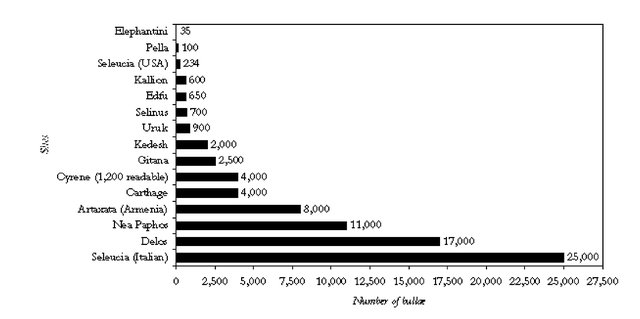
One of the debates surrounding ancient archives centers on their relation to state authority. It has long been recognized that not all archives are “official,” in the sense that they constitute royal or even municipal repositories of public records. Rather, many ancient archives are collections of personal records kept in individuals’ houses. The group of 17,000 seal impressions from a private house on Delos is the best example of this phenomenon (Boussac 1988; 1992). The criteria that are generally applied to determine the official or nonofficial nature of any given archive are the form of the building in which it was found and the nature of the representations on the bullae themselves.
A comparison of the archives found by the American and the Italian excavators at Seleucia can illustrate both the usefulness and pitfalls of these criteria. The bullae from the American excavations were found in small storerooms within private houses in an area of the city given over to private housing. Nonetheless, they carried a high percentage of official stamps, with 43 percent of Archive B and 12 percent of Archive A concerned with the salt tax. The 25,000+ bullae discovered by the Italians came from the quarter of the city given over to state functions (Invenizzi 2003, 315). The building in which they were found is far from domestic in plan. Measuring 140 m long and 6 m wide, it consists of two suites of seven long narrow interconnecting rooms, with bays for shelves on both sides (Invenizzi 1985; Le Rider 1998, pls. 14.2 and 15). This is a structure clearly designed for and dedicated to the storage of documents; the 25,225 sealings within attest to the enormous number of records kept there; 15,006 of these (59 percent) relate to the salt tax (Messina and Mollo 2004, 3–20). From this we can see that there is little difference in the percentage of official stamps in the private Archive B at Seleucia and the public archive building. Further, bullae bearing stamps from the same seals appear in both archives (Invenizzi 2003, 216). It appears that the owners of Archive B were in the habit of taking home duplicates of the records they deposited in the public archive.[5] This practice, if common elsewhere, calls into question the validity of distinguishing public from private archives on the basis of the stamps found within them.
The situation of the archive at Kedesh presents another variation. The 2,000+ bullae were recovered for the most part from a single room in a large Hellenistic administrative building (fig. 3). The concentration of sealings in a single room of a building the size and plan of which are most closely paralleled by Persian and Hellenistic period regional palaces led the excavators to believe that the group constitutes the remains of an official archive of a regional Seleucid administrator (Herbert and Berlin 2003, 48–54). The number of sealings from this group that can be definitively associated with any sort of state business is very small, however—around 5 percent of the total (Herbert and Berlin 2003, 51). Thus, the finds from Kedesh cast further doubt on the validity of using sealing type as a criterion for determining the public or private function of an archive.
Artistic Milieu
The thousands of individual seal impressions from the Kedesh and Seleucia archives are an invaluable resource for the study of artistic currents in the third- and second-century BCE Near East. The individual impressions on the private sealings present unique reflections of the mixed cultural milieux of populations at either end of the Seleucid Empire and have the potential to inform us in ways never before possible on issues of self-representation, interaction, and personal identity. The subject matter chosen for the seals and the iconography employed have much to tell us about the cultural affiliations of the owners and/or producers of the seals.[6]
Our understanding of the visual environment of the Hellenistic East has always been hampered by the dearth of original works of art. The usefulness of one of the largest bodies of originals that we do have—the thousands of carved rings and gems in museum collections—is limited because the vast majority of the gems lack any secure provenance or date, and style is a notoriously unreliable criterion by which to distinguish Hellenistic from Roman in this medium. Seal impressions from securely dated excavation contexts such as those from Kedesh and Seleucia can do much to remedy this situation.
The subjects depicted on the private sealings in the Kedesh and Seleucia collections are overwhelmingly Greek, with the Greek gods dominating the repertory (figs. 4, 5).[7] Among the most popular gods at both sites are Apollo, Athena, and Tyche. Athena is the most common figure at Seleucia, while at Kedesh she is surpassed by Apollo, Tyche, Aphrodite, and Hermes.[8] Local affiliations are reflected in the scattering of non-Greek gods in both collections: Tanit at Kedesh (Ariel and Naveh 2003) and Nanaia and Nabu at Seleucia (Bollati and Messina 2004, 33–34, 59–60). The prominence of the Greek gods in both collections would seem at first glance to argue for a standardized and overwhelming Hellenization of the visual language at both sites. A closer look at the variations between and within the two groups tells a different story. This can be demonstrated in a preliminary way by the treatments of three goddesses—Athena, Aphrodite, and Tyche—in the two collections.
Athena, the Greek goddess of war, wisdom, and crafts, appears at Kedesh as a full figure on 50 impressions from 39 seals. In addition, there are 16 sealings from 12 seals that carry a helmeted head of Athena. At Seleucia, the goddess is present in 663 impressions from 328 seals, 209 of which are full figures and 119 heads (Bollati and Messina 2004, 11–31). In terms of relative popularity among the users of the archive, the Athenas from Kedesh comprise roughly 10 percent of the seals that represent Greek gods; at Seleucia they represent ca. 17 percent. Almost all of the full-figure Athenas from both collections can be traced back to two well-known classical renditions of the goddess. Most popular by far is the so-called Promachos type, which shows the goddess actively involved in or preparing for combat (fig. 6, nos. Ath 1, 2). Second is the Parthenos type, a quieter figure, inspired by the chryselephantine statue created by Phidias for the Athenian Parthenon (fig. 6, nos. Ath 3–6). Both the Promachos and Parthenos types are common in other published Hellenistic collections of sealings and on the coinage of the Hellenistic monarchs.[9] All the collections of seals demonstrate the same homogeneity of Athena types. There seems to have been little interest in modifying the received classical iconography of the goddess to reflect local tastes or changing styles.
When we turn to Aphrodite, the Greek goddess of love and female sexuality, we find a very different situation, in terms of both relative popularity and choice of poses. There are comparatively few seals bearing the image of this goddess in the Seleucia collection—only 73 impressions from 63 rings, or 3.3 percent of the divine seals (Bollati and Messina 2004, 79–86). At Kedesh, by contrast, she appears on 78 impressions from 60 rings, which is a striking 11 percent of the seals depicting Greek gods. She clearly resonated much more powerfully with the people of Kedesh than those of Seleucia.
Aphrodite is differentiated from other goddesses in Hellenistic art by her nudity, whether full or partial. Although the nude female is not uncommon in Greek art of the late Archaic and Classical eras, it is only with the creation of the shockingly naked, for its time, Aphrodite of Knidos by Praxiteles in the mid-fourth century BCE that this goddess, or any other for that matter, is represented in a state of undress in Greek art. Previous to Praxiteles’ statue, female nudity had been associated with slaves and prostitutes.[10] The Knidia was followed shortly by other representations of a naked Aphrodite, most famously the painting by Apelles of her emerging from the sea—the so-called Anadyomene. In the art of the Hellenistic era, it is not possible to be certain whether any given nude female figure not obviously modeled on Praxiteles’ Knidia or other attested statues of Aphrodite does in fact represent Aphrodite or merely a mortal woman (Bieber 1961, 143; Merker 2000, 169). In recent years a consensus seems to have emerged to group these naked figures as Aphrodites, unless they are accompanied by attributes that mark them as maenads or muses (Smith 1991, 81–83; LIMC II s.v. Aphrodite, 46–62).[11]
There is a great deal of debate about the chronology of the development of Aphrodite types during the Hellenistic era, largely due to the scarcity of original statues from dated provenances.[12] A few fixed points are clear. The series starts with Praxiteles’ Knidia (Pliny NH 34.50), followed shortly by another by Skopas (Pliny NH 36.26)[13] and Apelles’ Anadyomene (Pliny NH 35.79–97).[14] Two originals dated to the late second century BCE by their dedicatory inscriptions—the Aphrodite of Melos and the Aphrodite, Pan, and Eros group from Delos—show that the naked and semidraped Aphrodite are firmly ensconced in the Hellenistic repertory by that time.[15] It is the intervening two centuries that are problematic. The well-dated sealings of Aphrodite from Seleucia and Kedesh insert an important fixed date into the debate over the development of the types. Although the relation between minor arts such as these and large public works is itself open to several interpretations, at the very least the sealings from Kedesh and Seleucia provide a variety of representations of the goddess that reflect the range of images extant in the Levant from the mid-third to the mid-second century BCE.[16]
The representations of Aphrodite from Kedesh and Seleucia come in a wide range of types, the three most common of which will be discussed here. The most popular Aphrodite at Kedesh, present on 26 impressions from 20 seals, is a lushly naturalistic naked figure bathing. She stands with one arm thrown over her back and is shown in a three-quarters pose from the rear (fig. 7, nos. Aph 1–3). There are a few seals of this type at Seleucia (Bollati and Messina 2004, 83, nos. Af 12–19). The type is virtually unknown from other seal collections.[17] It has no parallels in contemporary stone sculpture or terracottas.[18] In contrast, the second most common type at Kedesh, present in 14 impressions from 14 seals, falls quite easily into the widespread Anadyomene group, known from myriad sculptures and terracottas (LIMC II s.v. Aphrodite, 54–60, 76–77) (fig. 7, nos. Aph 4–9). In this guise, the goddess is shown frontal and nude with both arms raised to her head, as if wringing out or doing up her hair. The type is absent at Seleucia and rare in other Hellenistic collections of seals.[19] The other large group of Aphrodites from Kedesh are the so-called sandal-binder type, present on 19 impressions from 10 seals. In these the goddess is depicted bent over to undo or retie her sandal (fig. 7, no. Aph 12). This is the most common type at Seleucia (Bollati and Messina 2004, 83–84, nos. Af 22–40) and is well attested in Hellenistic and Roman art (Künzel 1970, 102–162; LIMC II s.v. Aphrodite, nos. 463–481).
One outstanding characteristic of the Kedesh assemblage is the clear preference for rear views. In three-dimensional art there is always some uncertainty about the angle from which the artist meant the viewer to approach the statue. There is in fact a good deal of debate about this aspect of the Knidia itself.[20] In two-dimensional renderings such as ours there is no doubt as to which viewpoint the artist intended. The popularity of the rear view as early as the first half of the second century BCE is of some interest in terms of the ancients’ concepts of the erotic. Lucian, writing in the second century CE, certainly portrayed the rear view of the Knidia to be the more sexually arousing to his viewers. This, coupled with his comparison of the Knidia thus viewed to Ganymede, imparts a certain androgeny and homoeroticism to this most female of figures.[21]
Of all the Aphrodite types from Kedesh, it is the Anadyomene, virtually unknown from other gem or seal collections, that is most interesting in terms of local tastes. The identifying feature of this type in sculpture is the position of the arms, both of which must be raised to the head. The pose most often shows the figure with her weight on the left leg and the body tilted in that direction, but examples with the weight reversed are not uncommon. The gaze is generally directed downward, either to the right or the left. Although the Kedesh sealings faithfully follow the generic Anadyomene pose as seen in sculptures, the overall effect is quite different. The weight is most often on the right leg, with the left bent, but the position as rendered is awkward, giving the figure a knock-kneed look. A more obvious deviation of the sealings from the sculpted versions is the lack of twist in the torso. Equally striking is the gaze, which (with one exception) is directly frontal, resulting in an almost frightening apotropaic stare (fig. 7, nos. Aph 4–9). An even more noticeable difference is the flat, crude rendering of the body: it seems almost disarticulated, with the frontal torso floating above the awkwardly twisted legs. This should not be written off as the ring carvers’ lack of skill. We have seen in the bather type (fig. 7, nos. Aph 1–3) that these craftsmen can produce a fleshed-out naturalistic female figure. In comparison, the treatment of the Anadyomene appears almost cartoonish.[22] It is hard to believe that the inspiration for this type could in any way derive from the work of Apelles, a painter who was famous for the grace and realism of his figures.[23] More likely the seal artists were striving for an altogether different effect.
The flat frontal appearance of the Anadyomene sealings bears a much greater resemblance to Near Eastern and Egyptian renderings of Astarte and Isis than to Greek Aphrodites (LIMC III addenda s.v. Astarte, 1087–1094; LIMC V s.v. Isis, 761–796). There is evidence for pre-Hellenistic worship of Isis and Astarte in Phoenicia.[24] Granted, the pose of the hands to the hair is not part of the Isis or Astarte iconography, but they do bring their arms to waist level or above to raise their skirts or display other attributes, and the Phoenician goddess Tanit is normally shown with hands raised to head.[25] The hair of our Anadyomene sealings is in several examples distinctly wiglike and similar to representations of Isis. From this brief overview of the Aphrodite types we can see, then, that the people of Kedesh not only had a special affinity for Aphrodite but also that they modified the iconography of this Greek goddess to bring her closer to goddesses worshiped in the area before the coming of the Greeks. Viewed from this angle, the iconography of Aphrodite Anadyomene at Kedesh can be interpreted as evidence for the “orientalization” of a Greek goddess as well as the Hellenization of the local population.
With Tyche (fig. 8), the final goddess in this study, we have another variation of the modification and intermingling of Greek and local beliefs and iconography. The Tyche types are of particular interest because she was not one of the original gods of the Greek pantheon and only became widely popular in the Hellenistic era.[26] The iconography, developing as it did without a strong classical tradition upon which to draw, might be more directly reflective of local traditions and concerns. The form in which the goddess appears on both the Kedesh and Seleucia sealings is Agathe Tyche, the goddess of good fortune represented as a standing draped female figure with a cornucopia. She is the most popular choice for seal rings at both sites, appearing on 104 impressions from 86 rings at Kedesh and 914 impressions from 322 rings at Seleucia, or 17 percent of the seals of Greek gods from both sites (Bollati and Messina 2004, 121–142).
The standing figure with cornucopia is one of two Tyche types made popular in the Hellenistic era. The other, and by far the more famous, is a seated figure. These two iconographical types represent very different conceptualizations and sets of functions. They suggest, in fact, that we are dealing with two different deities. The posture and attributes of the seated figure cast her as a communal city goddess; those of the standing goddess point to a more personal deity. The communal type begins with the monumental bronze sculpture of the Tyche of Antioch by Eutychides, which Seleucus I commissioned shortly after the foundation of the city in 300 BCE. The original has been lost, but many replicas survive from which the major attributes of the type can be reconstructed with confidence (LIMC I s.v. Antiocheia, 840–851). The Tyche of Antioch is firmly located geographically, seated on Mt. Silpios over the river Orontes. She wears a turreted crown, representing the walls of the city, and most likely carried a palm branch in her right hand.[27] The essential feature of this communal Tyche is the turreted crown; she does not carry a cornucopia in the earlier replicas, although this is occasionally added to her attributes in the Roman era. This conceptualization of the goddess as a guardian spirit of the city became enormously popular and was adopted by more than fifty cities by the second century CE (Broucke 1994, 40). The turreted head alone is a popular symbol on Hellenistic and Roman coins as a personification of the city (LIMC VIII s.v. Tyche, 123, nos. 89–93; Burnett et al. 1992, 794; Bollati 2003). The standing representations show a draped female figure with a cornucopia in one hand and one of several attributes—the torch, scepter, stalk of grain, and rudder are the most common—in her other (LIMC VIII s.v. Tyche, 119–21, nos. 20–65). In this guise she rarely wears the turreted crown but appears most often bareheaded or with a polos or Isis crown. This, too, seems to be a Hellenistic invention.[28] The connections with Isis grow over time and must be a key aspect of her poularity in the Hellenistic and Roman eras.
These two forms of the goddess appear in different spheres of art, one more common in the public arts and the other in the private. The city goddess serves the community and commonly appears on “official” art such as coinage. She is not, at least as originally conceived, connected with fertility or personal prosperity as symbolized by the cornucopia, stalk of wheat, polos, and Isis crown of the Agathe Tyche type. Instead, she bears symbols of political power and martial victory. In this form she rarely appears on sealings, and when she does these are state seals (LIMC I s.v. Antiocheia, 849, no. 127). Conversely, the type with cornucopia and polos rarely appears on state art such as coins in the Hellenistic era but is common on individual seal rings. As Agathe Tyche, she represents the personal fortune of individuals and evolves into the immensely popular Fortuna of the Roman era. That these two iconographical types were perceived as different gods by the ancients is clear from a number of Roman gemstones on which the seated city Tyche and the Agathe Tyche/Fortuna with cornucopia appear side by side (LIMC I s.v. Antiocheia, 848–849, nos. 104–120).
These two functions, the public and the private, overlap somewhat when Tyche is conceived as the personal divinity of a monarch. In these instances, such as the coinage of Demetrios I and Antiochos VIII, the Tyche with cornucopia appears on public art (Houghton 1983, nos. 143–166, 689–692). The best examples of the invocation of the personal Tyches of Hellenistic monarchs come on a series of Ptolemaic oinochoai from Alexandria. On these a female figure carrying a cornucopia is identified by inscription as the Agathe Tyche of specific kings and queens (Thompson 1973). In some instances she is also equated with Isis (Thompson 1973, nos. 1, 142, 144, 146). The series starts with Arsinoe II in the early third century and continues into the second century BCE. In some instances, the heads of the Tyche figures are portraits of the queens (Thompson 1973, Arsinoe II nos. 1, 2, 5, 126, 128, 129; Berenike II nos. 25, 29, 75, 102, 271, 130). As the Hellenistic era progresses, the use of Agathe Tyche as a goddess of personal good fortune becomes widely popular, particularly in the Near East, which had a tradition of such personal guardian spirits (Thompson 1973, 52; van der Toorn 1996, 80, nos. 76, 99).
It is in the form of the personal Agathe Tyche with cornucopia that Tyche appears almost exclusively on the sealings in the Kedesh and Seleucia archives.[29] Although the cornucopia can be associated with other goddesses, most often Demeter, by the middle Hellenistic era it is firmly connected with Agathe Tyche, who takes on many of the attributes of Demeter, as well as of Isis and Artemis (Thompson 1973; LIMC VIII, 1 s.v. Tyche, no. 123). Agathe Tyche is a popular figure on seals in the Hellenistic East, and the Kedesh and Seleucia archives are certainly not unusual in their numbers of Tyche representations. She comprises 4.2 percent of the identified impressions at Uruk and is prominent as well in the Delos archive (Boussac 1988, 330).[30] She also appears in the large group from Paphos on Cyprus (Nicolaou 1978, 851). Interestingly, she is not common in the known Hellenistic archives from Greece and the West. There are no examples from the 600+ sealings found at Kallion (Pantos 1985) and a single piece out of the 600+ from Selinus (Salinas 1883, no. CII). Similarly, only four examples appear among the 876 Greek-style impressions from Carthage (Berges 1997, nos. 478–481). In the Roman era, she is much more widely diffused as either Fortuna or Agathe Tyche.[31] It seems clear from this distribution that the popularity of Agathe Tyche on seals developed in the East in the Hellenistic era and only moved West under the Romans.
The rise of Agathe Tyche and her assimilation of the roles and attributes of Demeter and Isis are symptomatic of the mixed cultural milieu and hybridization of the Hellenistic world.[32] Although this is sometimes viewed as a one-way Hellenization of the eastern gods, recent scholarship has shown it to be a reciprocal process in which Greek gods can be seen to be “orientalized” as well (Invenizzi 1998; Serwint 2002). The figure of Agatha Tyche, the mixed iconography of which is essentially an invention of the Hellenistic era, is an excellent example of the complexity of this process.
In conclusion, the three most popular Greek goddesses present in the seal collections of Kedesh and Seleucia show three different kinds of interaction between local and Greek traditions as reflected in their visual imagery. In the case of Athena, we see the assimilation of the classical Greek goddess with almost no modification. With Aphrodite, the iconography of the goddess as Anadyomene undergoes changes that reflect the continuing loyalty to cults to Isis and Astarte in Phoenicia. It is in Tyche that we have the most complex and wide-ranging set of transformations. The original concept of the personal guardian spirit, or lamassu, of Mesopotamia, commonly represented as an animal/bird/human mix, takes on the form and attributes of an anthropomorphized minor Greek deity, who in turn takes on the attributes of the Egyptian goddess Isis. In her Roman incarnation as Bona Fortuna, this figure is among the most widespread and long-lasting of the ancient world.
Notes
McDowell published these promptly as Archives A and B. The first contained 85 bullae and was found below level III of block G6 in room 360; the second yielded 81 pieces and was found in room 116 of the same block and level (Hopkins 1972, 30). Along with these McDowell published another 39 bullae from scattered findspots at Seleucia. At the time of his publication McDowell believed the two archives to be from a single house, but further study has shown them to be in different houses (Hopkins 1972, 30). For a critique of McDowell’s hypotheses about the function of the archives, see Brown 1938.

There were then some 3,300 known seal impressions from five ancient sites: Cyrene (Maddoli 1963/1964), Elephantine (Rubensohn 1907), Edfu (Milne 1916), Selinus (Salinas 1883), and Uruk (Rostovtzeff 1932). For recent overviews of these and other excavated collections, see Plantzos 1999, 27–32 and Berges 1997, 33–41.

These numbers exclude the 100,000+ sealings recently found at Zeugma (http://www.zeugmaweb.com/zeugma/english/engindex.htm). The number of Hellenistic archives is not altogether certain because some of the examples stayed open beyond the Hellenistic era (Cyrene) and others were in use before (Carthage). Still others have been found displaced from their original context, such as the Paphos sealings (which come from fill below a Roman house) and the Zeugma bullae (which are from disturbed fills).

Related information on papyrus archives comes from the plethora of papyrus documents discovered in Egypt, which testify to the variety of transactions recorded—sales and leases, wills, marriage contracts, manumissions, and innumerable tax receipts and exemptions. These, however, come down to us for the most part recycled as cartonnage in animal mummies and have been stripped of their seals. It is rare to find both document and seals preserved together since the unbaked clay sealings are usually only preserved when the archive is burned, thereby destroying the papyrus records. The main exceptions to this rule are the 35 seals from Elephantine and the Late Persian documents from Wadi Daliyeh (Leith 1997). Vandorpe (1995) collects the 180 sealings found with papyri in Egypt, including those from Elephantine. The only other instances in which we can connect seals with their documents are Persian and Hellenistic cuneiform tablets (see Wallenfels 1996; Garrison and Root 2001). Thus, most of the so-called archives that we have, including those from Seleucia and Kedesh, consist of clay sealings without their documents and present serious difficulties in interpretation.

Duplicate contracts are well attested on clay tablets from Seleucid Iraq (Bregstein 1996, 57 n. 23).

While we cannot know to what extent the subject matter of seals was dictated by the tastes of the customers versus the interests of artisans who made them, the images on the seals must reflect the visual vocabulary extant in the areas of their use.

The largest single category from Kedesh is the portrait heads, with 344 pieces; but the total of the various gods is double that, at 788 sealings. The study of the Kedesh material is still in progress, so these numbers may change slightly when the work is complete. I have assembled figure 5 from the published catalogue of the Seleucia archive (Bollati and Messina 2004); the numbers in this graph represent seals rather than impressions. There are ca. 6,100 impressions from 1,883 seals of the Greek gods in the archive.

The smaller archives from the Michigan excavations show a similar distribution. McDowell identified fifteen Athena and fourteen Tyche sealings; Dionysos surpassed Apollo among the male gods by six to three (McDowell 1935, 74–89). In the remainder of the article, I will be using only the figures from the Italian excavation, which provide a more than sufficient sample for comparative purposes.

Cyrene: Maddoli 1963/1964, nos. 23–60; Kallion: Pantos 1985, nos. 218–230; Seleucia (American): McDowell 1935, 77–80, nos. 1–9; Uruk: Lindström 2003, nos. 85-2, 92-1, 111-1, 113-1, 114-1, 201-2, 217-1, 219-1, 244-1, 245-1, 252-2, 297-2, 453-2, 468-1.2, 511-1, 512-1, 608-1, 634-1, *29-3; Selinus: Salinas 1883, types 88, 89; Carthage: Berges 1997, nos. 496–503. The collection from Edfu contained only heads of the goddess.

That the nakedness of the goddess was indeed shocking is reflected in the ancient lore about Praxiteles’ Knidia; a narrative grew up in antiquity to explain her nudity that she had been caught unaware at her bath (Pliny NH 34.50; Lucian Imagines 6, Amores 13–14; Anthologia Graeca 16.160). In Greek art of the Mycenaean and Geometric periods, there had been naked renderings of Aphrodite, in all likelihood inspired by oriental representations of Ishtar/Astarte (LIMC II s.v. Aphrodite, nos. 349–362). These had disappeared from the Greek repertory by the Archaic period (Stewart 1997, 102).

In a sense, this distinction is irrelevant. Merker (2000, 169) makes the point well in her discussion of the terracotta figurines from the Demeter sanctuary at Corinth: “Whether a figurine depicted a nude woman, a courtesan or Aphrodite, the point must have been to invoke a sense of Aphrodite for the worshipper and to allow the mortal to identify with the deity.”

For a succinct overview of the debate, see Havelock 1995, 69–101.

Although Pliny does not say explicitly that the Knidia is the first nude Aphrodite, he implies this with the story that the Koans rejected the naked statue in favor of the clothed one on the grounds of propriety.

Again, Pliny does not explicitly state that Apelles’ Anadyomene is naked, but his speculation that Apelles’ model was the courtesan Pankaspe, whom he painted naked for Alexander, implies this (NH 35.87). A similar story that the Anadyomene was inspired by Praxiteles’ mistress Phryne when she disrobed and entered the sea at the celebration of the Eleusinian mysteries (Athenaios 13, 590) also implies that the painting was of a nude.

On the date of the Melian Aphrodite, see Ridgway 2000, 167–171; Havelock 1995, 93–97. For the Delos group, see Ridgway 2000, 147–149; Havelock 1995, 55–58.

There is a general tendency to see smaller-scale renderings in terracotta figurines and on gems as derivative from larger works of art and to seek the “Urbild” for these in lost originals (Havelock 1995, 6–7). Some authors acknowledge, however, that there may be cases in which the process is reversed (Ridgway 1990, 8; 2000, 270; Merker 2000, 172). This issue has broader ramifications than the tracing of stylistic trends: it has the potential to inform us on the changing interactions between public and popular art and allows us to locate the origin of certain views in the private sphere of popular art.

There are two from Uruk: Lindström 2003, nos. 221-3, 76-2. The former is exactly the same pose as the Kedesh examples; in the latter she has a water pot to her right.

The large-scale marble statue known as the Farnese Kallipygos, which shows a woman admiring her buttocks as she drops her drapery to expose them, is either a very late Hellenistic or early Roman work (Saflund 1963; Havelock 1995, 99–101). In any case, the pose and dress of our seals is very different from the statue. A variant of this pose, in which the goddess is shown semidraped from the rear is present in small numbers from both collections (fig. 7, nos. Aph 10, 11; Bollati and Messina 2004, 85, nos. 45–47).

There are two Anadyomene bullae from Cyrene (Maddoli 1963/1964, nos. 145–146). A fragmentary piece from Kallion shows a frontal nude with the surviving right arm raised to the hair (Pantos 1985, no. 214). While the Hellenistic date of the Kallion group is secure, the Cyrene archive stayed open until the early second century CE, and seals from there can be Roman in date. The Anadyomene type is not uncommon on Graeco-Roman gems from undated contexts (Furtwängler 1900, pl. 43, nos. 46–47; Maaskant-Kleibrink 1978, no. 524). A gem from Alexandria, now in Munich, is dated to the last quarter of the fourth century BCE on stylistic grounds (Brandt 1968, no. 354). The Kedesh collection provides the earliest secure date for the gems of this type.

Pliny NH 36.20; Lucian Amores 14; Osborne 1994, 84; Stewart 1997, 103–104.

Lucian Amores 14: “What a fine rhythm to her back! Great flanks! What a handful to embrace! Look at the way the beautifully delineated flesh of the buttocks is arched. . . . So that’s what Ganymede looks like when he pours out nectar for Zeus.” See Stewart 1997, 228–229 for Hermaphrodites and “gender slippage” in Hellenistic art.

We do have one sealing that is “anatomically correct” (fig. 7, no. Aph 9).

Pliny NH 35.79, 92–94. The most memorable anecdote about this realism is the story of the horses that neighed when shown a horse painted by Apelles (Pliny NH 35.95).

Closest to Kedesh is the Iron Age sanctuary at Mizpe Yammin (Frankel 1993). Also worth noting is a sixth-century BCE situla from Memphis with a Phoenician inscription to Isis (McCarter 1993). There are also 24 seals of Isis herself in the Kedesh collection.

See Serwint 2002, figs. 2 and 9. For a text citing Astarte’s Mesopotamian counterpart, Inanna, as the “binder of hair,” see Serwint 2002, 326.

Tyche first appears in Greek myth in Hesiod’s Theogony (l.360) as one of the 3,000 daughters of Ocean. By Classical times, she comes to be seen as the personification of luck or fortune, both good and bad, and a powerful force in the lives of men (LIMC VIII, 1 s.v. Tyche, 115). She was worshiped in Athens in the early fourth century as Agathe Tyche, or good luck (Inscriptiones Graecae II.2, 4564). Although rarely (if at all) represented in Archaic or Classical art, she becomes a popular subject in the Hellenistic era (Pollitt 1986, 3; Matheson 1994).

There is disagreement about what attributes she originally held. The earliest representation of the statue appears on a coin of Tigranes II minted at Antioch and dated to 83–69 BCE; there she holds a palm branch, the symbol of victory (Stansbury-O’Donnell 1994, fig. 32). In later versions she holds a stalk of grain, the symbol of fertility and wealth (Stansbury-O’Donnell 1994, fig. 33).

Pausanias (4.30.6) cites a statue of Agathe Tyche with cornucopia by the sixth-century BCE sculptor Boupalos at Smyrna. There has been much debate about the validity of Pausanias’s early date for this Boupalos (Heidenreich 1935; Rumpf 1936), but it is generally believed today that the statue he saw was most likely a late Hellenistic archaizing piece (LIMC VIII, 1 s.v. Tyche, 124). Two lost statues by the fourth-century sculptor Praxiteles are also cited in ancient sources (Pliny NH 36.23; Aelian VH 9.39).

There are four examples of the coin type of the turreted head from Kedesh.

For the American excavations at Seleucia, see McDowell 1935, 85–90, nos. 1–14; for Uruk, see Lindström 2003, nos. 2-2, 123-1, 156-2, 201-3, 215-3, 215-4, 267-3, 297-1, 352-2, 412-1, 478-1, 501-1, 501-2, 524-1, 591-1, 591-2. For Delos, see Boussac 1988, nos. 21, 24, 49, 53.

Cf. the groups at Aquilea: Sena Chiesa 1966, nos. 235–248; Cyrene: Maddoli 1963/1964, nos. 188–254.

The culmination of this mixing can be seen in the so-called Pantheistic Fortuna on a gem in the British Museum, where she wears an aegis and lotus flower and carries a rudder, caduceus, and ears of corn in her right hand, with a cornucopia and bird in her left, and a star, crescent, serpent, wreaths, palm branch (?), bow, scepter (?), and club of Herakles in the field (Walters 1926, no. 1754).

Works Cited
Ariel, D., and J. Naveh. 2003. “Selected Inscribed Sealings from Kedesh in the Upper Galilee.” Bulletin of the American Schools of Oriental Research 329:61–80.
Berges, D. 1997. “Die Tonsiegeln aus dem Karthagischen Temple Archiv.” In Karthago, vol. 2: Die deutschen Ausgrabungen in Karthago, ed. F. Rakob, 10–213. Mainz am Rhein: von Zabern.
Bieber, M. 1961. The Sculpture of the Hellenistic Age. New York: Columbia University Press.
Bollati, A. 2003. “Tyche sulle cretule da Seleucia al Tigri.” Parthica 5:33–37.
Bollati, A., and V. Messina. 2004. Seleucia al Tigri: le impronte di sigillo dagli archivi, vol. 2: Divinità, ed. A. Invernizzi. Turin: Edizioni dell’Orso.
Boussac, M.-F. 1988. “Sceaux déliens.” Revue Archéologique 307–340.
———. 1992. Sceaux publics, Apollo, Hélios, Artémis, Hécate. Les sceaux de Délos 1. Paris: De Boccard.
Bregstein, L. 1996. “Murasu Archives.” In Archives et sceaux du monde hellénistique [= Archivi e sigilli nel mondo ellenistico; Torino, Villa Gualino, 13–16 Gennaio 1993], Bulletin de correspondance hellénique suppl. 29, ed. M.-F. Boussac and A. Invenizzi, 53–61. Athens: École Française d’Athènes.
Brandt, E. 1968. Antike Gemmen in deutschen Sammlungen I. Griechische Gemmen von minoischer Zeit bis zum späten Hellenismus. Munich: Staatliche Münzsammlung München.
Broucke, P. B. F. J. 1994. “Tyche and the Fortune of Cities in the Greek and Roman World.” In An Obsession with Fortune: Tyche in Greek and Roman Art, ed. S. B. Matheson, 35–48. New Haven, Conn.: Yale University Art Gallery.
Brown, F. E. 1938. Review of R. H. McDowell, Stamped and Inscribed Objects from Seleucia on the Tigris (Ann Arbor 1935). American Journal of Archaeology 42:608–610.
Burnett, A. M., M. Amandry, and P. Ripollés Alegre. 1992. Roman Provincial Coinage. London: British Museum Press; Paris: Bibliothèque Nationale.
Frankel, R. 1993. “Mizpe Yam.” In The New Encyclopedia of Archaeological Excavations in the Holy Land, vol. 3, ed. E. Stern, 1061–1063. Jerusalem: The Israel Exploration Society.
Furtwängler, A. 1900. Die antiken Gemmen: Geschichte der Steinschneidekunst im klassischen Altertum. Leipzig and Berlin: Giesecke & Devrient.
Garrison, M. B., and M. C. Root. 2001. Seals on the Persepolis Fortification Tablets: vol. 1, Images of Heroic Encounter. Chicago: Oriental Institute of the University of Chicago.
Havelock. C. 1995. The Aphrodite of Knidos and Her Successors. Ann Arbor: University of Michigan Press.
Heidenreich, R. 1935. “Bupalos und Pergamon.” Archäolögischer Anzeiger 50:668–701.
Herbert, S. C., and A. Berlin. 2003. “A New Administrative Center for Persian and Hellenistic Galilee: Preliminary Report of the University of Michigan/University of Minnesota Excavations at Kedesh.” Bulletin of the American Schools of Oriental Research 329:13–59.
Hopkins, C. 1972. Topography and Architecture of Seleucia on the Tigris. Ann Arbor: The University of Michigan.
Houghton, A. 1983. Coins of the Seleucid Empire in the Collection of Arthur Houghton. New York: American Numismatic Society.
Invenizzi, A. 1985. “Seleucia sul Tigri.” In La Terra tra i due fiumi: venti anni di archeologia italiana in Medio Oriente, la Mesopotamia dei Tesori, ed. E. Quarantelli, 92–126. Turin: Quadrante.
———. 1998. “Osservazioni in margine al problema della religione della Mesopotamia ellenizzata.” Electrum 2:87–99.
———. 2003. “They Did Not Write on Clay.” In Ancient Archives and Archival Traditions: Concepts of Record-keeping in the Ancient World, ed. M. Brosius, 302–322. Oxford: Oxford University Press.
Künzel, E. 1970. “Venus vor den Bade—ein Neufund der Colonia Ulpia traiana und Bemerkungen zum ‘sandalösen Aphrodite’.” Bonner Jahrbücher des rheinischen Landesmuseums in Bonn und des Vereins von Altertumsfreunden im Rheinlande 170:102–162.
Le Rider, G. 1998. Séleucie du Tigre: les monnaies séleucides et parthes. Florence: Le Lettere.
Leith, M. J. W. 1997. Wadi Daliyeh: The Wadi Daliyeh Seal Impressions. Oxford and New York: Clarendon Press.
LIMC = Lexicon Iconographicum Mythologiae Graecae. 1981–. 8 vols. Zurich and Munich: Artemis Verlag.
Lindström, G. 2003. Uruk: Siegelabdrücke auf hellenistischen Tonbullen und Tontafeln. Mainz am Rhein: von Zabern.
Maaskant-Kleibrink, M. 1978. Catalogue of the Engraved Gems in the Royal Coin Cabinet, The Hague. Wiesbaden: Franz Steiner.
Maddoli, G. 1963/1964. “Le cretule del Nomophylakion di Cirene.” Annuario della Scuola Archeologica di Atene 41–42:40–145.
Matheson, S. B. 1994. “The Goddess Tyche.” In An Obsession with Fortune: Tyche in Greek and Roman Art, ed. S. B. Matheson, 19–33. New Haven, Conn.: Yale University Art Gallery.
McCarter, K. 1993. “An Inscribed Phoenician Funerary Situla in the Art Museum of Princeton University.” Bulletin of the American Schools of Oriental Research 290.1:115–120.
McDowell, R. 1931. “‘Bullae’ Stamped with Greek Legends.” In Preliminary Report upon the Excavations at Tel Umar, Iraq, ed. L. Waterman, 26–42. Ann Arbor: University of Michigan Press.
———. 1935. Stamped and Inscribed Objects from Seleucia on the Tigris. Ann Arbor: University of Michigan Press.
Merker. G. S. 2000. The Sanctuary of Demeter and Kore: Terracotta Figurines of the Classical, Hellenistic, and Roman Periods. Corinth XVIII, part IV. Princeton: The American School of Classical Studies.
Messina, V., and P. Mollo. 2004. Seleucia al Tigri: le impronte di sigillo dagli archivi, vol. 1: Sigilli ufficiali, ritratti, ed A. Invernizzi. Turin: Edizioni dell’Orso.
Milne, J. G. 1916. “Ptolemaic Seal Impressions.” Journal of Hellenic Studies 36:87–101.
Nicolaou, K. 1978. “Oriental Divinities Represented on the Clay Sealings of Paphos.” In Hommages à Maarten J. Vermaseren: recueil d’études offert par les auteurs de la série Études préliminaires aux religions orientales dans l’Empire romain à Maarten J. Vermaseren à l’occasion de son soixantième anniversaire le 7 avril 1978, ed. M. B. de Boer and T. E. Edridge, 849–853. Leiden: Brill.
Osborne, R. 1994. “Looking on—Greek Style. Does the Sculpted Girl Speak to Women Too?” In Classical Greece: Ancient Histories and Modern Archaeologies, ed. I. Morris, 81–96. Cambridge: Cambridge University Press.
Pantos, A. P. 1985. The Seals from Aetolian Kallipolis (in Greek). Athens: University of Athens.
Plantzos, D. 1999. Hellenistic Engraved Gems. Oxford and New York: Clarendon Press.
Pollitt, J. J. 1986. Art in the Hellenistic Age. Cambridge: Cambridge University Press.
Ridgway, B. 1990. Hellenistic Sculpture, vol. 1. Madison: University of Wisconsin Press.
———. 2000. Hellenistic Sculpture, vol. 2. Madison: University of Wisconsin Press.
Rostovtzeff, M. 1932. “Seleucid Babylonia: Bullae and Seals of Clay with Greek Inscriptions.” Yale Classical Studies 3:1–114.
Rubensohn, O. 1907. Elephantine-Papyri. Berlin: Weidmann.
Rumpf, A. 1936. “Zu Bupalos und Athenis.” Archäolögischer Anzeiger 51:52–64.
Saflund, G. 1963. Aphrodite Kallipygos. Uppsala: Almquist and Wiksell.
Salinas, A. 1883. “Selinunte.” Notizie degli scavi di antichità 287–314.
Sena Chiesa, G. 1966. Gemme del Museo Nazionale di Aquileia. Padua: Associazione Nazionale per Aquileia.
Serwint, N. 2002. “Aphrodite and Her Near Eastern Sisters: Spheres of Influence.” In Engendering Aphrodite: Women and Society in Ancient Cyprus, ed. D. Bolger and N. Serwint, 325–350. Boston: American Schools of Oriental Research.
Smith, R. R. R. 1991. Hellenistic Sculpture. New York: Thames and Hudson.
Stansbury-O’Donnell, M. 1994. “Reflections of the Tyche of Antioch in Literary Sources and Coins.” In An Obsession with Fortune: Tyche in Greek and Roman Art, ed. S. B. Matheson, 50–63. New Haven, Conn.: Yale University Art Gallery.
Stewart, A. 1997. Art, Desire and the Body in Ancient Greece. Cambridge: Cambridge University Press.
Thompson, D. B. 1973. Ptolemaic Oinochoai and Portraits in Faience: Aspects of the Ruler-Cult. Oxford: Clarendon Press.
van der Toorn, K. 1996. Family Religion in Babylonia, Syria, and Israel: Continuity and Changes in the Forms of Religious Life. Leiden and New York: Brill.
Vandorpe, K. 1995. Breaking the Seal of Secrecy: Sealing-Practices in Greco-Roman and Byzantine Egypt Based on Greek, Demotic and Latin Papyrological Evidence. Leiden: Institute of Papyrology.
Wallenfels, R. 1996. “Private Seals and Sealing Practices at Hellenistic Uruk.” In Archives et sceaux du monde hellénistique [= Archivi e sigilli nel mondo ellenistico; Torino, Villa Gualino, 13–16 Gennaio 1993], Bulletin de correspondance hellénique suppl. 29, ed. M.-F. Boussac and A. Invenizzi, 113–123. Athens: École Française d’Athènes.
Walters, H. B. 1926. Catalogue of the Engraved Gems and Cameos, Greek, Etruscan and Roman in the British Museum. London: Trustees of the British Museum.


